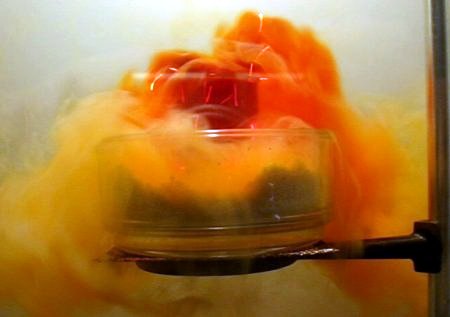Uses:
Perchloric acid
Perchloric acid is used as a precursor in Ammonium Perchloride, a rocket fuel. Due to the growth in rocketry, production of Perchloric has increased significantly, with several million kilograms of perchloric acid being produced annually. Due to Perchloric acid being a strong oxidizer, it is used to make perchlorate salt (fireworks and rocket propellants). Perchloric acid is subjected to strict safety regulations because of its strong oxidizing properties. It is higly reactive with metals and organic matter.
Video: http://www.youtube.com/watch?v=JrWPWJvzYIM&feature=player_embedded
Hydrogen Bromide (dissolved in water becomes Hydrobromic acid)
It is used primarily in chemical synthesis. Reacting hydrogen bromide with methanol gives us Bromoethane which is used for industrial and agricultural activities.
Hydrogen Iodide (aqueous form is hydroiodic acid)
Hydroiodic acid is a solution of pure HI in water. HI is a useful reducing agent. Reduction with HI and red phosphorus is the most popular method to produce Methamphetamine in the United States. It can also be used to make various chemical compounds of iodine.

Acknowledgements: Yahoo answers
Wikipedia
YouTube
Interesting facts about these acids:
PERCHLORIC ACID

Ø At room temperature you can wash your hands with 72.5% perchloric acid!!!
Ø Depending on the form of the perchlorate, it can spontaneously explode when subjected to mild shock (such as a vibrating flue)
Ø Perchloric Acids can be formed by distilling its salts with Sulfuric Acid.
Ø Perchloric Acid in the form of Aqueous solutions only develop oxidizing power with heat or above 70% concentration of reactant.
HYDROGEN BROMIDE

Ø Spills of hydrobromic acid can be neutralized by mixing weak bases such as sodium bicarbonate, soda ash, or slaked lime to the spill.
Ø Contact between hydrogen bromide and strong oxidizers like ammonia, fluorine, or common metals such as, copper, brass and zinc mixed together
with moisture may cause explosive reactions to occur.
Ø When Hydrogen Bromide is mixed with fluorine, a fire may break out. The evolution of dangerous, toxic and corrosive fumes may occur
when this substance mixes with water or steam. It can also react instantaneously with ozone which causes undesirable consequences such as explosion.

Reaction between aluminium and bromide after 10 seconds
HYDROGEN IODIDE
Ø First known use of Hydrogen Iodide was in 1869
Ø British physicians recommended a similar range of daily intake of iodine in the form of hydrogen iodide as the ranges of iodine
recommended by U.S. physicians in the form of Lugol solution
Ø They are one of the healthiest nations based on overall well being and cancer statistics.7 Japanese women do not stop
consuming iodine-rich foods during pregnancy
Ø Hydrogen iodide is a controlled substance as it can be used to make methamphetamine.
*methamphetamine-- a central nervous system stimulant
LINKS:
http://yarchive.net/chem/perchloric_acid.html
http://en.wikipedia.org/wiki/Perchloric_acid
http://www.bromicacid.com/favechem.htm#16
http://www.osha.gov/SLTC/healthguidelines/hydrogenbromide/recognition.html
http://www.livestrong.com/article/117399-properties-hydrogen-iodide/#ixzz1yDPODypg
http://www.longnaturalhealth.com/health-articles/iodine
Ions they contain or produce in water.
Perchloric Acid:These solids consist of the perchlorate anion linked via hydrogen bonds to H2O and H3O+ centers[6]Perchloric acid forms an azeotrope with water, consisting of
about 72.5% perchloric acid. This form of the acid is stable indefinitely and is commercially available. Such solutions are hygroscopic.This form of the acid is stable indefinitely and is
commercially available. Such solutions are hygroscopic. Thus, if left open to the air, concentrated perchloric acid dilutes itself by absorbing water from the air.
Hydrogen bromide: It is very soluble in water, forming hydrobromic acid solution, which is saturated at 68.85% HBr by weight at room temperature. Aqueous solutions that are 47.38% HBr by weight form a constant-boiling mixture (reverse azeotrope) that boils at 126°C. Boiling less concentrated solutions releases H2O until the constant boiling mixture composition is reached.
Hydroiodic acid: A solution of pure HI in water. Commercial hydroiodic acid usually contains 57% HI by mass. The solution forms an azeotrope boiling at 127 °C with 57% HI, 43% water.Hydroiodic acid is one of the strongest of all common acids due to the high stability of its corresponding conjugate base. The iodide ion is the largest of all common halides which results in the negative charge being dispersed over a larger space. By contrast, a chloride ion is significantly smaller, meaning its negative charge is more concentrated, leading to a stronger interaction between the proton and the chloride ion. This weaker H+---I– interaction in HI facilitates dissociation of the proton from the anion, and is the reason HI is the strongest acid of the hydrohalides (except for hydroastatic acid [theoretically]).